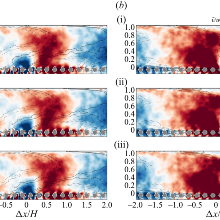New joint publication (University of Stuttgart/Max Planck Institute for Intelligent Systems/), published in Journal of Fluid Mechanics. The work has been developed within the SFB 1313 research projects A02.
Authors
- Wenkang Wang (Max Planck Institute for Intelligent Systems, former SFB 1313 researcher, task force "experiments")
- Adrián Lozano-Durán (
- Rainer Helmig (University of Stuttgart, SFB 1313 research projects A02 and C02)
- Xu Chu (University of Stuttgart, former SFB 1313 researcher, research project A02)
Abstract
The interaction between boundary layer turbulence and a porous layer is the cornerstone of interface engineering. In this study, the spatial and spectral-resolved transfer entropy is used to assess the asymmetry of the causal interaction next to the permeable wall. The analysis is based on pore-resolved direct numerical simulation of turbulent channel flow over cylinder arrays. The spatial map of transfer entropy reveals the information flux between the porous medium and arbitrary nearby positions, and paths connecting locations with maximum information transfer are identified. The paths in the ‘top-down’ and ‘bottom-up’ directions, respectively, lean upstream and downstream, demonstrating that the coupling process is directionally dependent. The scale dependence of transfer entropy is inspected with a surrogate data strategy. As wall permeability increases, the active scale range in causal interaction shifts from near-wall vortices to Kelvin–Helmholtz type eddies. In addition, linear stochastic estimation is used to determine the statistical velocity field for a local informative event. In an average sense, the interaction between a convecting sweep or ejection event and the up/down-welling motions at the pore unit is the core mechanism that contributes to the causal coupling. The statistical findings derived from the transfer entropy are then validated using a neural network-based remote sensing model.

Wenkang Wang
(Ph. D.)Postdoctoral Researcher

Rainer Helmig
Prof. Dr.-Ing. Dr.-Ing. h.c.Principal Investigator, Former Spokesperson, Research Projects A02 and C02, Central Project Z

Xu Chu
Dr.-Ing.Postdoctoral Researcher, Research Project A02


